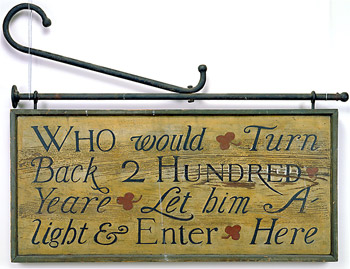Deerfield Arts & Crafts home page
Ideas
Films and Pageants, Portraying Colonial Heritage

© Memorial Hall Museum, Pocumtuck Valley Memorial Association
Deerfield Souvenir Shop Sign
Tourists could purchase souvenirs, such as postcards, story books, paper dolls or cookie cutters of the 'Little Captives of 1704' at the Olde Deerfield Doll House which was also a tea shop. A sign outside the shop promised, "Who would turn Back 2 Hundred Yeare Let him Alight & Enter Here." Dorothea Hyde, sign for the Olde Deerfield Doll House c. 1923.
Who would Turn back 2 Hundred Years?
From what were tourists averting their gaze when they decided to "turn back 2 hundred years" with a nostalgic trip to "old Deerfield"? Characterized by rapidly growing cities and vastly increasing immigrant populations, early-twentieth-century America would have seemed unsettling to anyone who disliked change. In 1910, for instance, the nation continued to face unrestrained European immigration; a circumstance that many believed was threatening the very identity of the United States. In the single year of 1907 over five times as many people immigrated to the U.S. as had done so a decade earlier. These increasing immigrant populations tended to concentrate in American cities, which were, themselves, growing at an ever-increasing pace. The total population of the nation's five largest cities doubled in the twenty years between the census of 1890 and 1910. From 1900 to 1910 between 35 and 40 percent of the people who lived in New York City and Boston were foreign born. The average population density for those cities was over 16,000 people per square mile.1 Interestingly, the average tourist visiting old Deerfield was likely unaware that the population of Deerfield's Franklin County included a significant number of Eastern European immigrants.
- Cambell Gibson, Population of the 100 Largest Cities and other Urban Places in the United States: 1790 to 1990, Population Division, U.S. Bureau of the Census Washington, D.C. Population Division Working Paper No. 27, June 1998, http://www.census.gov/population/www/documentation/twps0027/twps0027.html; Reports of the Immigration Commission, "Statistical Review of Immigration, 1820-1910"; Distribution of Immigrants, 1850-1900" Senate Documents, Volume 20, (Washington, Government Printing Office), 1911.